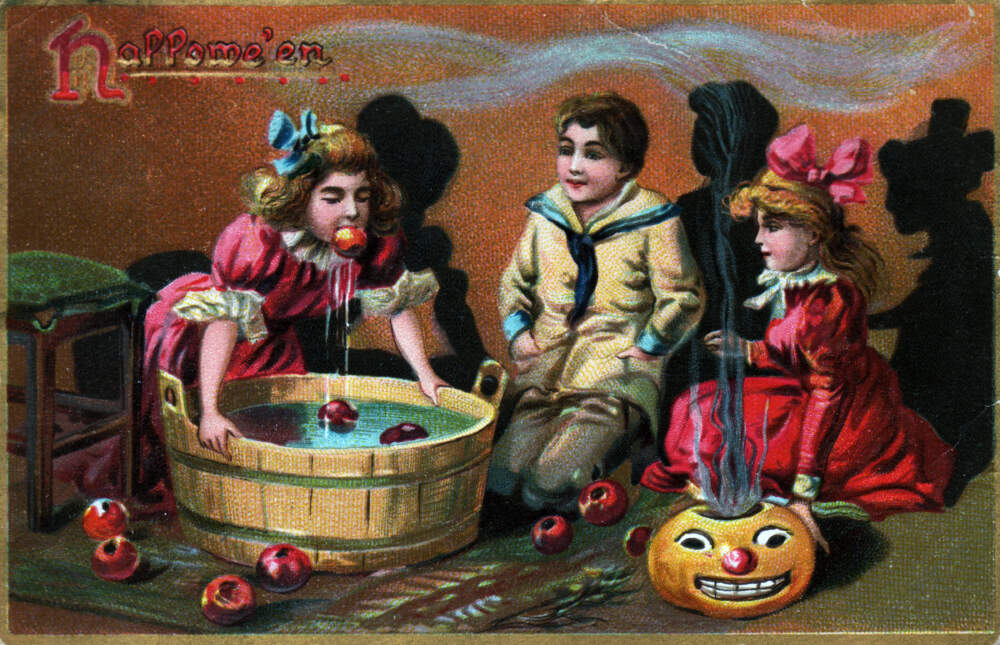Advertisement
Before trick-or-treating, Halloween in Massachusetts was mayhem
Resume
Halloween is here, and hoards of costumed kids will be parading through neighborhoods (likely with their parents) asking politely for treats. But before trick-or-treating became the holiday's tradition, it seems utter pandemonium ruled. Candy historian Susan Benjamin was inspired to do some research to find out more.
“I really wanted to get to the bottom of Halloween,” she recalled, “because everybody's always asking me, 'Trick or treat, when did that start? What was the candy they ate?'”
So Benjamin went digging through old Boston Globe articles dating back to the late 1800s and early 1900s. “What I found was reporting that went everywhere from hysteria to humor to fears,” she said. “And what's really funny about it — and sort of disturbing too — is that all these antics were happening with kids who just raged through the streets. And, as the reporters tell us, [they] did untold amounts of damage.”
A 1913 article described youngsters running wild while pulling all manner of pranks. Benjamin pointed to another from 1921 that reported this Halloween scene in Winthrop:
“The spirit of Halloween ran riot through the town last night, gripping young and old alike, propelling them onto fun and mischief. From the police point of view the observance was equal to any night before the Fourth celebration. The only difference was the lack of firecrackers. The little boys, and big ones too, cut up ‘something terrible,’ and kept the police on the jump.”
Devilish kids also got their kicks pulling fire alarms. In the countryside, Benjamin said, barns were set ablaze. Back in the city, they lit fires in playgrounds. The Boston Globe listed a slew of 1923 events in Brookline:
“The fire department hopped about here and there, putting the quietus on Halloween stunts last evening. The record for the evening was as follows: Box 41 sounded for a grass fire on the Shaw Estate, Chestnut st; bonfire, opposite 229 Chestnut st while the other fire was in progress; still alarm for grass fire on Boylston st Playground…”
In 1928, Benjamin said youngsters wearing costumes, face paint or masks ran amok through office buildings and stores in Boston. “And in Cambridge, a bunch of kids somehow got hold of a giant moose and led it down the streets with great hilarity.” According to The Globe, it was determined that the animal was actually “an example of taxidermist art.”
By the mid to late-1920s, Benjamin said newspaper reporters began covering the need for change, “focusing on what individual towns were doing to make sure that the kids had someplace to go and would stop disturbing all the rest of community life.”
Their solutions ran the gamut, from organizing parades to much stranger diversions. Concord's was particularly bizarre. “They had rat chasing events where kids — yes kids — caught rats. Probably to keep the rat population down," Benjamin said of the 1935 Boston Globe article she discovered. "The Cambridge Fire Department, meanwhile, enlisted Boy Scouts to stop kids from pulling the alarms.”
Then there were the parties. Lots of them, as the Globe also reported in 1935:
“The weirdness of Halloween has been [enclosed] in safer spooks. There are parties everywhere, children's parties, grown-ups' parties, parties where the old-time bobbing for apples, the candy twists, the dark trips through the cellar, the goblin appearances provide the entertainment.”
According to a 1940 article, the police even held social events on Halloween which “notably limited damage and lawless pranks.”
But Benjamin said all these parties came with a downside because “somebody had to host them.” To the relief of many a parent, trick-or-treating entered the picture.
“That started around the 1940s, although reporters did indicate that there was trick-or-treating in Wellesley in the 1920s,” Benjamin said. “It didn't really take off until the 1940s because of packaging. And now, candy makers everywhere could give a boost to their sales by packaging little hand-sized candy bags.”
From there on in, residents could stay home to sate neighborhood children treats with those convenient little packages. “Very nice, very neat, very orderly,” Benjamin said. “Then they would go home, go through this stash, and the streets would be relatively empty.”
So these days, if you're feeling overwhelmed by the little patrols of kids going up and down your street on Halloween, Benjamin said take heart. “Feel good about it. It could be worse. You could have your garden overthrown, or you could have a fire in the lot behind your house.”
Candy historian and author Susan Benjamin grew up in Brookline and owns True Treats, a history-based candy shop in Harper's Ferry, West Virginia.
This segment aired on October 31, 2023.
